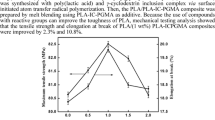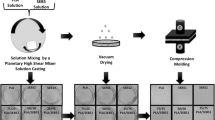Abstract
In this work, a series of linear and star-shaped poly(ε-caprolactone)s (SPCL) with various arm numbers were successfully synthesized with ring-opening polymerization (ROP) with the initiators having different number of hydroxyl functional groups. The molecular characteristics of synthesized PCLs were analyzed via Fourier Transform Infrared Spectroscopy (FTIR), proton nuclear magnetic resonance spectra (1H NMR), thermogravimetric analyzer (TGA), differential scanning calorimetry (DSC) and gel permeation chromatography (GPC) measurements. Then PCLs were melted with poly(lactic acid) (PLA) by utilizing a micro-compounder at a constant blending ratio (90/10% weight) and constant 1,4-phenylene diisocyanate (PDI) (1% weight) as a commercial compatibilizer. It was reported that adding SPCL improved mechanical properties of PLA. The three-armed star shaped PCL (3SPCL) caused significant decrease in modulus due to its high molecular chain mobility when compared linear, four- and six-armed PCLs. An increment was observed in the elongation at break values with incorporation of star polymers and it increased from 4 to 9%. Scanning electron microscopy (SEM) photos indicated that immiscibility of the two biodegradable polymers were enhanced and thus mechanical improvement were achieved.











Similar content being viewed by others
References
Kodal M, Sirin H, Ozkoc G et al (2019) Long-and short-term stability of plasticized poly (lactic acid): effects of plasticizers type on thermal, mechanical and morphological properties. Polym Bull 76(1):423–445
Tuna B, Ozkoc G et al (2017) Effects of diisocyanate and polymeric epoxidized chain extenders on the properties of recycled poly (lactic acid). J Polym Environ 25(4):983–993
García-Campo MJ, Boronat T, Quiles-Carrillo L, Balart R, Montanes N et al (2018) Manufacturing and characterization of toughened poly (lactic acid) (PLA) formulations by ternary blends with biopolyesters. Polymers 10(1):3
Drumright RE, Gruber PR, Henton DE et al (2000) Polylactic acid technology. Adv Mater 12(23):1841–1846
Liu Z, Hu D, Huang L, Li W, Tian J, Lu L, Zhou C et al (2018) Simultaneous improvement in toughness, strength and biocompatibility of poly (lactic acid) with polyhedral oligomeric silsesquioxane. Chem Eng J 346:649–661
Mauck SC, Wang S, Ding W, Rohde BJ, Fortune CK, Yang G, Ahn S-K, Robertson ML et al (2016) Biorenewable tough blends of polylactide and acrylated epoxidized soybean oil compatibilized by a polylactide star polymer. Macromolecules 49(5):1605–1615
Huang Y, Chang R, Han L, Shan G, Bao Y, Pan P et al (2016) ABA-type thermoplastic elastomers composed of poly (ε-caprolactone-co-δ-valerolactone) soft midblock and polymorphic poly (lactic acid) hard end blocks. ACS Sustainable Chem Eng 4(1):121–128
Ojijo V, Ray SS et al (2015) Super toughened biodegradable polylactide blends with non-linear copolymer interfacial architecture obtained via facile in-situ reactive compatibilization. Polymer 80:1–17
Raquez J-M, Habibi Y, Murariu M, Dubois P et al (2013) Polylactide (PLA)-based nanocomposites. Prog Polym Sci 38(10–11):1504–1542
Carvalho JR, Conde G, Antonioli ML, Dias PP, Vasconcelos RO, Taboga SR, Canola PA, Chinelatto MA, Pereira GT, Ferraz GC et al (2020) Biocompatibility and biodegradation of poly (lactic acid)(PLA) and an immiscible PLA/poly (ε-caprolactone)(PCL) blend compatibilized by poly (ε-caprolactone-b-tetrahydrofuran) implanted in horses. Polymer J 52:629–643
Ostafinska A, Fortelný I, Hodan J, Krejčíková S, Nevoralová M, Kredatusová J, Kruliš Z, Kotek J, Šlouf M et al (2017) Strong synergistic effects in PLA/PCL blends: Impact of PLA matrix viscosity. J Mech Behav Biomed Mater 69:229–241
López-Rodríguez N, López-Arraiza A, Meaurio E, Sarasua J et al (2006) Crystallization, morphology, and mechanical behavior of polylactide/poly (ε-caprolactone) blends. Polym Eng Sci 46(9):1299–1308
Takayama T, Todo M et al (2006) Improvement of impact fracture properties of PLA/PCL polymer blend due to LTI addition. J Mater Sci 41(15):4989–4992
Todo M, Harada A, Tsuji H et al (2007) Fracture characterizarion of biodegradable PLLA polymer blends. 16th International conference on composite materials, Kyoto 1–6
Wachirahuttapong S, Thongpin C, Sombatsompop N et al (2016) Effect of PCL and Compatibility Contents on the Morphology, Crystallization and Mechanical Properties of PLA/PCL Blends. Energy Procedia 89:198–206
Urquijo J, Guerrica-Echevarría G, Eguiazábal JI et al (2015) Melt processed PLA/PCL blends: Effect of processing method on phase structure, morphology, and mechanical properties. J Appl Polym Sci 132(41):42641–42649
Chen H, Yu X, Zhou W, Peng S, Zhao X et al (2018) Highly toughened polylactide (PLA) by reactive blending with novel polycaprolactone-based polyurethane (PCLU) blends. Polym Test 70:275–280
Simões C, Viana J, Cunha A et al (2009) Mechanical properties of poly (ε-caprolactone) and poly (lactic acid) blends. J Appl Polym Sci 112(1):345–352
Vainio MH, Karjalainen T, Seppala J et al (1996) Biodegradable lactone copolymers. 1. Characterization and mechanical behavior of epsilon-caprolactone and lactide copolymers. J Appl Polym Sci 59:1281–1288
Patrício T, Bártolo P et al (2013) Thermal stability of PCL/PLA blends produced by physical blending process. Procedia Eng 59:292–297
Yeh J-T, Wu C-J, Tsou C-H, Chai W-L, Chow J-D, Huang C-Y, Chen K-N, Wu C-S et al (2009) Study on the crystallization, miscibility, morphology, properties of poly (lactic acid)/poly (ε-caprolactone) blends. Polym-plast. Tech. Eng. 48(6):571–578
Broz M, VanderHart DL, Washburn N et al (2003) Structure and mechanical properties of poly (D, L-lactic acid)/poly (ε-caprolactone) blends. Biomaterials 24(23):4181–4190
Semba T, Kitagawa K, Ishiaku US, Hamada H et al (2006) The effect of crosslinking on the mechanical properties of polylactic acid/polycaprolactone blends. J Appl Polym Sci 101(3):1816–1825
Rao RU, Suman KNS, Rao VVSK, Bhanukıran K et al (2011) Study of rheological and mechanical properties of biodegradable polylactide and polycaprolactone blends. Int J Eng Sci Tech 6259–6265
Coleman MM, Serman CJ, Bhagwagar DE, Painter PC et al (1990) A practical guide to polymer miscibility. Polymer 31(7):1187–1203
Meredith JC, Amis EJ et al (2000) LCST phase separation in biodegradable polymer blends: poly(D, L-lactide) and poly(ϵ-caprolactone). Macromol Chem Phys 201(6):733–739
Yang J-M, Chen H-L, You J-W, Hwang JC et al (1997) Miscibility and Crystallization of Poly(L-lactide)/Poly(ethylene glycol) and Poly(L-lactide)/Poly(ε-caprolactone) Blends. Polymer J 29(8):657–662
Navarro-Baena I, Sessini V, Dominici F, Torre L, Kenny JM, Peponi L et al (2016) Design of biodegradable blends based on PLA and PCL: From morphological, thermal and mechanical studies to shape memory behavior. Polym Degrad Stab 132:97–108
Doganci E, Gorur M, Uyanik C, Yilmaz F et al (2014) Synthesis of AB 3-type miktoarm star polymers with steroid core via a combination of “Click” chemistry and ring opening polymerization techniques. J Polym Sci Part A: Polym Chem 52(23):3390–3399
Qin Y, Liu S, Zhang Y, Yuan M, Li H, Yuan M et al (2014) Effect of poly (ɛ-caprolactone-co-L-lactide) on thermal and functional properties of poly (L-lactide). Int J Biol Macromol 70:327–333
Deokar MD, Idage SB, Idage BB, Sivaram S et al (2016) Synthesis and characterization of well-defined random and block copolymers of ε-caprolactone with l-lactide as an additive for toughening polylactide: Influence of the molecular architecture. J Appl Polym Sci 133(14):43267–43279
Li H, Qiao T, Song P, Guo H, Song X, Zhang B, Chen X et al (2015) Star-shaped PCL/PLLA blended fiber membrane via electrospinning. J Biomater Sci, Polym Ed 26(7):420–432
Doganci E, Davarci D et al (2019) Synthesized and mesomorphic properties of cholesterol end-capped poly (ε-caprolactone) polymers. J Polym Res 26(7):165–175
Doganci E, Gorur M, Uyanik C, Yilmaz F et al (2014) Supramolecular inclusion complexes of a star polymer containing cholesterol end-capped poly (ε-caprolactone) arms with β-cyclodextrin J Polym Sci. Part A: Polym Chem 52(23):3406–3420
Blackwell CJ, Haernvall K, Guebitz GM, Groombridge M, Gonzales D, Khosravi E et al (2018) Enzymatic degradation of star poly (ε-caprolactone) with different central units. Polymers 10(11):1266–1281
Choi J, Kim I-K, Kwak S-Y et al (2005) Synthesis and characterization of a series of star-branched poly (ε-caprolactone) s with the variation in arm numbers and lengths. Polymer 46(23):9725–9735
Wang J-L, Dong C-M et al (2006) Physical properties, crystallization kinetics, and spherulitic growth of well-defined poly(ε-caprolactone)s with different arms. Polymer 47(9):3218–3228
Doganci MD, Aynali F, Doganci E, Ozkoc G et al (2019) Mechanical, thermal and morphological properties of poly (lactic acid) by using star-shaped poly (ε-caprolactone) with POSS core. Eur Polym J 121:109316–109329
Dogan SK, Reyes EA, Rastogi S, Ozkoc G et al (2014) Reactive compatibilization of PLA/TPU blends with a diisocyanate. J Appl Polym Sci 131(10):40251–40261
Wang H, Sun X, Seib P et al (2001) Strengthening blends of poly (lactic acid) and starch with methylenediphenyl diisocyanate. J Appl Polym Sci 82(7):1761–1767
Eren O, Gorur M, Keskin B, Yilmaz F et al (2013) Synthesis and characterization of ferrocene end-capped poly (ε-caprolactone) s by a combination of ring-opening polymerization and “click” chemistry techniques. React Funct Polym 73(1):244–253
Şahin ZM, Doğancı E, Yıldız SZ, Tuna M, Yılmaz F, Yerli Y, Görür M et al (2010) Synthesis and characterization of two-armed poly (ɛ-caprolactone) polymers initiated by the Schiff’s base complexes of copper (II) and nickel (II). Synth Met 160(17–18):1973–1980
Aoki D, Uchida S, Takata T et al (2015) Star/Linear Polymer Topology Transformation Facilitated by Mechanical Linking of Polymer Chains. Angew Chem Int Ed 54(23):6770–6774
Kodal M, Sirin H, Ozkoc G et al (2014) Effects of reactive and nonreactive POSS types on the mechanical, thermal, and morphological properties of plasticized poly (lactic acid). Polym Eng Sci 54(2):264–275
Torres N, Robin J, Boutevin B et al (2001) Chemical modification of virgin and recycled poly (ethylene terephthalate) by adding of chain extenders during processing. J Appl Polym Sci 79(10):1816–1824
Kilic NT, Can BN, Kodal M, Ozkoc G et al (2019) Compatibilization of PLA/PBAT blends by using Epoxy-POSS. J Appl Polym Sci 136(12):47217
Zhao H, Zhao G et al (2016) Mechanical and thermal properties of conventional and microcellular injection molded poly (lactic acid)/poly (ε-caprolactone) blends. J Mech Behav Biomed Mater 53:59–67
Monticelli O, Calabrese M, Gardella L, Fina A, Gioffredi E et al (2014) Silsesquioxanes: novel compatibilizing agents for tuning the microstructure and properties of PLA/PCL immiscible blends. Eur Polym J 58:69–78
Matta A, Rao RU, Suman K, Rambabu V et al (2014) Preparation and characterization of biodegradable PLA/PCL polymeric blends. Procedia Mater Sci 6:1266–1270
Migliaresi C, Cohn D, De Lollis A, Fambri L et al (1991) Dynamic mechanical and calorimetric analysis of compression-molded PLLA of different molecular weights: Effect of thermal treatments. J Appl Polym Sci 43(1):83–95
Lim LT, Auras R, Rubino M et al (2008) Processing technologies for poly(lactic acid). Prog Polym Sci 33(8):820–852
Author information
Authors and Affiliations
Corresponding author
Additional information
Publisher’s Note
Springer Nature remains neutral with regard to jurisdictional claims in published maps and institutional affiliations.
Supplementary Information
Below is the link to the electronic supplementary material.
Rights and permissions
About this article
Cite this article
Doganci, M.D. Effects of star-shaped PCL having different numbers of arms on the mechanical, morphological, and thermal properties of PLA/PCL blends. J Polym Res 28, 11 (2021). https://doi.org/10.1007/s10965-020-02380-2
Received:
Accepted:
Published:
DOI: https://doi.org/10.1007/s10965-020-02380-2




